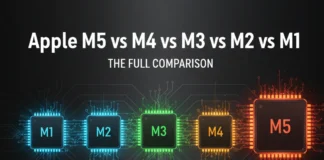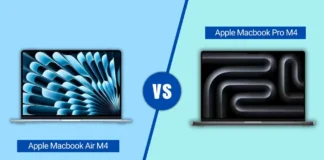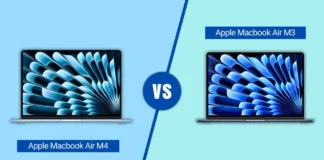You’ve just unboxed a new 4K monitor, plugged it into your laptop, and suddenly, you’re wondering why animations feel sluggish or your external SSD isn’t hitting top speeds. That’s when the “Thunderbolt 4 vs Thunderbolt 5” question hits.
Thunderbolt 5 doubles the bandwidth of Thunderbolt 4, unlocks higher refresh rates, powers more displays, and charges laptops faster, but the upgrade only makes sense if your setup pushes current limits. If you’re editing 8K video, running an external GPU, or connecting multiple high-refresh monitors, TB5 could be a game-changer.
If your work is mostly office apps, streaming, and light photo editing, TB4 remains more than capable, and far cheaper.
In this guide, we’ll compare Thunderbolt 5 vs Thunderbolt 4 side-by-side, real specs, real benchmarks, and real-world use cases, so you can decide if the upgrade is worth it in 2025.
Thunderbolt 5 Speed, Specs, and Features
Announced in late 2023 and rolling into devices in 2025, Thunderbolt 5 raises the bar: base bandwidth doubles to 80 Gbps, offer a “Bandwidth Boost” mode (up to 120 Gbps) for display-heavy workloads, upgrades PCIe to 4.0 x4, expands DisplayPort to 2.1, and increases supported power delivery to higher wattages, all while remaining backward compatible.
Thunderbolt 4 Speed, Specs, and Features
Released in 2020, Thunderbolt 4 standardized the 40 Gbps top speed with improved reliability, security, and compatibility. It supports robust video options (DisplayPort 1.4), PCIe 3.0 x4 for external storage, daisy-chaining multiple devices, and up to 100 W USB Power Delivery for charging laptops.
Also read: 10 Best Laptops with Thunderbolt 4 in 2025
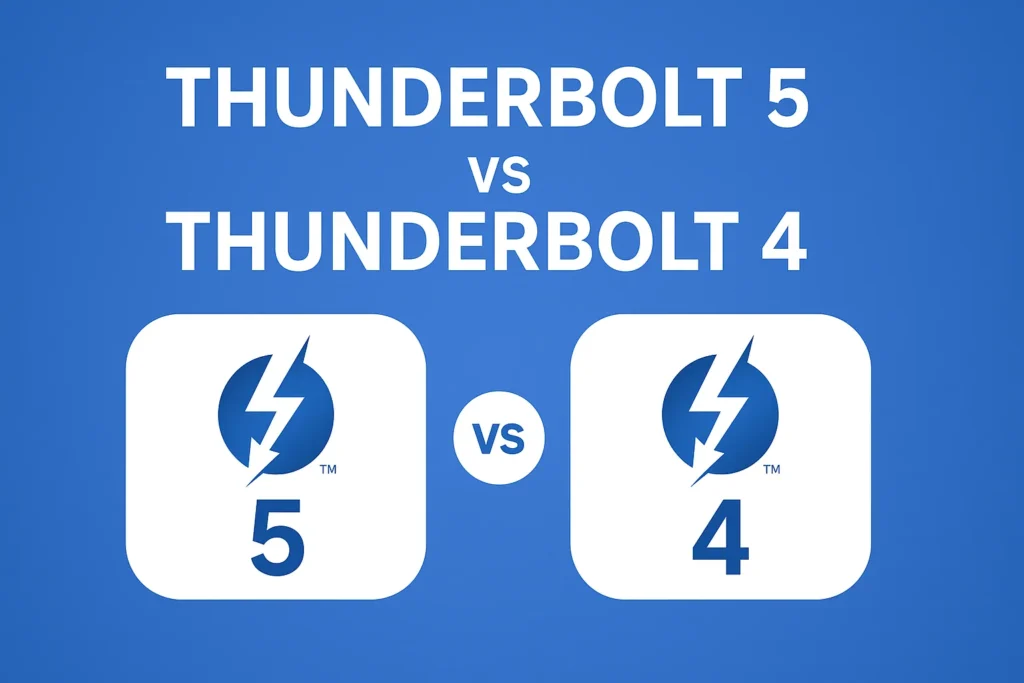
Thunderbolt 4 vs Thunderbolt 5: Performance, & Specs
| Feature / Spec | Thunderbolt 4 | Thunderbolt 5 | Real-World Impact | Winner |
| Maximum Bandwidth | 40 Gbps bidirectional | 80 Gbps bidirectional, 120 Gbps (Bandwidth Boost) | Double the speed = smoother multi-monitor setups & faster data transfers | TB5 |
| PCIe Data Speed | PCIe 3.0 x4 (32 Gbps) | PCIe 4.0 x4 (64 Gbps) | Faster NVMe SSD & eGPU performance | TB5 |
| External SSD Speed | ~2,800 MB/s | ~6,700 MB/s | Large files transfer in nearly half the time | TB5 |
| 4K Display Support | 2× @ 60Hz | 3× @ 144Hz | More monitors at higher refresh rates | TB5 |
| 8K Display Support | 1× @ 60Hz | 2× @ 60Hz or 1× @ 120Hz | High-end creative setups without compression | TB5 |
| Charging Power | Up to 100W | Up to 240W | Charges high-performance laptops faster | TB5 |
| Cable Length (Passive) | 0.8m max full speed | 1m max full speed | Slightly more flexibility in desk setup | TB5 |
| Backward Compatibility | TB3, USB4, USB 3.2 | TB4, TB3, USB4 v2, USB 3.2 | Works with more standards | TB5 |
| Device Availability (2025) | Widespread (2020+) | Limited premium (2025+) | Easier to find & cheaper | TB4 |
| Starting Price (Laptops) | Under $1,500 | From $2,499 | Better for budget buyers | TB4 |
| Best For | General productivity, mainstream use | Creative pros, gamers, future-proofing | TB5 only worth it if you push hardware limits | Depends |
Maximum bandwidth
Thunderbolt 4 tops out at 40 Gbps. Thunderbolt 5 doubles that to 80 Gbps and can temporarily reach higher uni-directional speeds for displays (Bandwidth Boost). That increased headroom is what unlocks higher refresh rates and more simultaneous high-resolution displays.
PCIe / external devices
Thunderbolt 4 exposes PCIe 3.0 x4 (32 Gbps) to external devices. Thunderbolt 5 moves to PCIe 4.0 x4 (64 Gbps), significantly improving external NVMe SSD and eGPU throughput.
Display capabilities
Thunderbolt 4 reliably supports one 8K monitor or two 4K monitors at 60 Hz. Thunderbolt 5, with DisplayPort 2.1 support and higher bandwidth, handles more displays and higher refresh rates (e.g., multiple 4K @144Hz or advanced 8K setups).
Power delivery
Thunderbolt 4 supports up to 100 W via USB Power Delivery. Thunderbolt 5 increases supported charging power, enabling higher-wattage laptop charging over a single cable and reducing the need for separate power bricks.
Backward compatibility & cables
Both versions are backward compatible with Thunderbolt 3 and USB standards. Full performance on Thunderbolt 5 requires certified TB5 cables (and active cable options for longer runs). Existing TB4 cables will work but may limit maximum TB5 speeds.
Daisy-chaining and device management
Both generations support daisy-chaining multiple devices from a single port. Thunderbolt 5 provides higher available bandwidth per device, improving performance in multi-device setups.
Also Read: Thunderbolt 4 vs. Thunderbolt 3: What’s the Difference?
Why Thunderbolt 5 is a Big Upgrade Over Thunderbolt 4
When choosing between Thunderbolt 4 and Thunderbolt 5, it’s less about “newer is better” and more about what you actually do with your computer. Here’s how to decide:
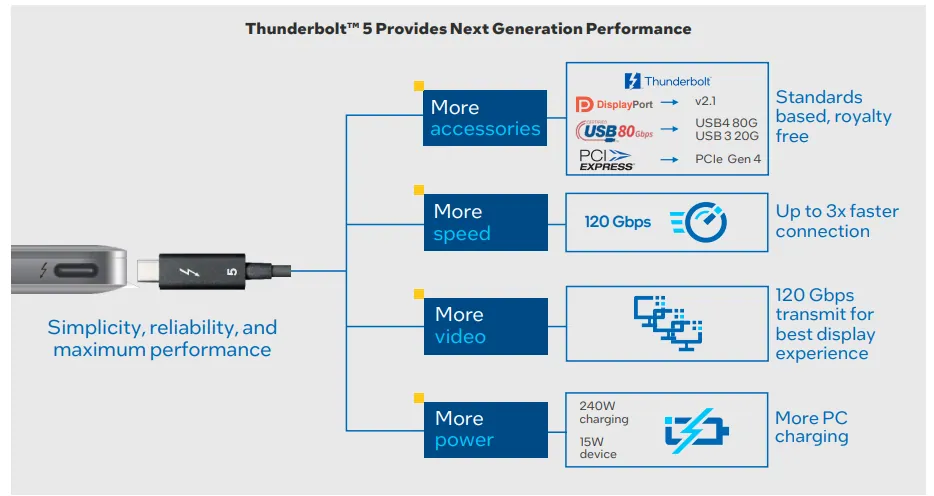
Who Should Choose Thunderbolt 5
- Content Creators – If you edit 4K/8K video, work with RAW photo files, or juggle multiple high-refresh monitors, TB5’s doubled bandwidth and DisplayPort 2.1 support will save you hours in exports and previews.
- Gamers with External GPUs – TB5’s PCIe 4.0 x4 interface gives eGPUs far less bottlenecking, leading to better frame rates and smoother gameplay at high refresh rates.
- High-Performance Laptop Users – Up to 240W charging means you can power demanding laptops and devices with a single cable.
- Future-Proof Seekers – If you upgrade hardware often or want your setup ready for next-gen VR, AR, and AI workloads, TB5 keeps you ahead of the curve.
Who Should Stick with Thunderbolt 4
- Office & Everyday Users – If your tasks are mostly documents, spreadsheets, Zoom calls, or streaming, TB4 is already more than fast enough.
- Budget-Conscious Buyers – TB4 devices start under $1,500, with docks and accessories well under $100.
- Mainstream Creators – For single 4K monitors, standard SSD transfers, and casual gaming, TB4 delivers excellent performance without the premium cost.
Pros & Cons at a Glance
| Thunderbolt 4 | Thunderbolt 5 |
|---|---|
| ✅ Widely available & more affordable | ✅ Double the bandwidth (80Gbps), up to 120Gbps for displays |
| ✅ Compatible with TB3 & USB4 devices | ✅ Supports triple 4K @144Hz or dual 8K |
| ✅ Stable performance for most tasks | ✅ Faster eGPU & SSD performance |
| ❌ Limited to 40Gbps bandwidth | ✅ Up to 240W charging for demanding laptops |
| ❌ Slower with high-end multi-display setups | ❌ Expensive, limited availability (2025) |
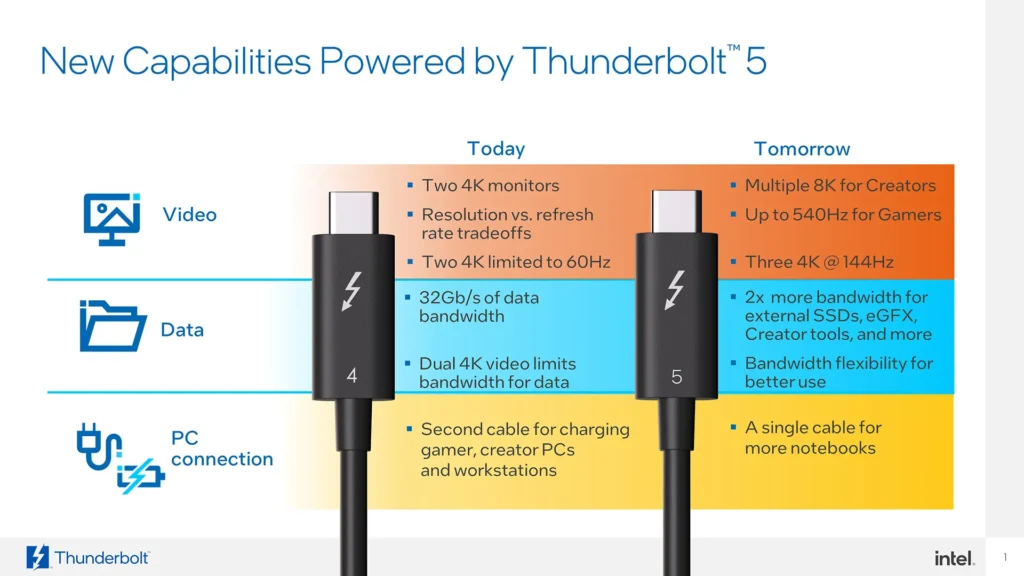
Thunderbolt 5 vs Thunderbolt 4:Current Pricing and Availability (2025)
Thunderbolt 5 is still new in 2025, so devices using it are mainly in the premium category. You’ll find it in high-end laptops, workstations, desktops, and a growing range of accessories. Pricing varies depending on the product type, but here’s an overview:
Thunderbolt 5 Devices list
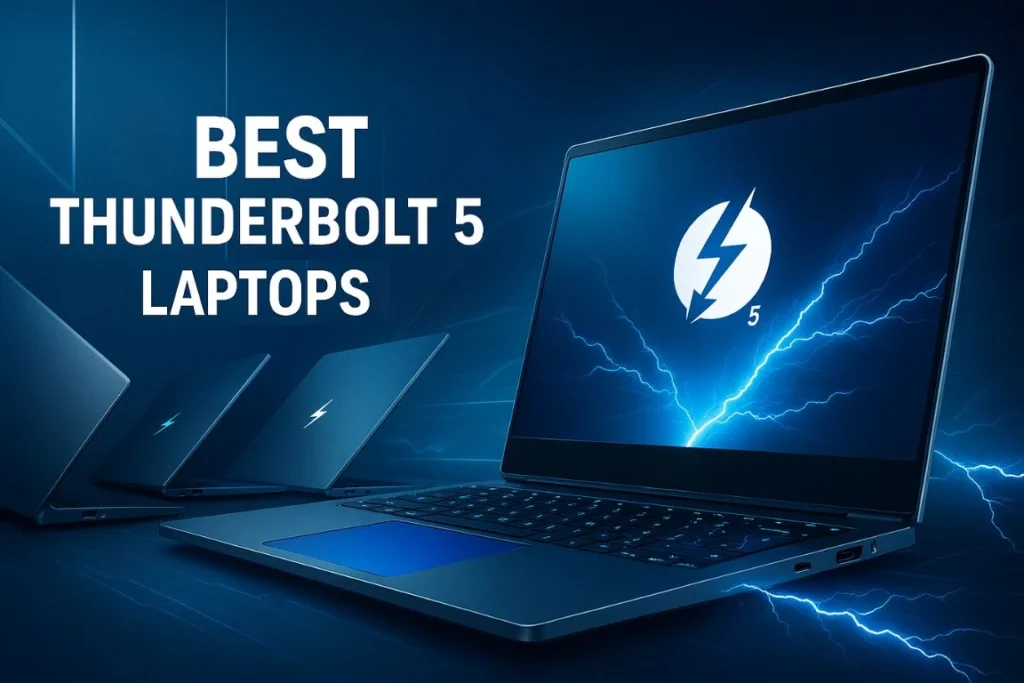
Laptops with Thunderbolt 5
- Apple MacBook Pro 16-inch (M4 Pro/M4 Max) – From $2,499
- ASUS ROG Strix G16 (2025) – Dual TB5 ports, up to 3× TB4 bandwidth
- Razer Blade 18 (2025) – Two TB5 ports, gaming-focused
- ASUS ROG Flow Z13 (2025) – Portable gaming powerhouse, Intel Core i9
- Acer Predator Helios 16 & 18 – Intel Core Ultra 9 275HX, up to 2 TB5 ports
- Alienware 16 & 18 Area-51 – Two TB5 ports for high-end GPU setups
- ASUS ROG Strix Scar 16 & 18 – Designed for competitive gaming, up to 2 TB5 ports
- Gigabyte AORUS Master 16 & 18 – One TB5 port
- MSI Vector 16 HX AI & Vector 18 HX AI – All-purpose laptops with dual TB5 ports
- MSI Raider 18 HX AI & MSI Titan 18 HX AI – Dual TB5 ports for extreme performance
- Lenovo Legion 9 18 – High-end gaming, dual TB5 ports
We will add more laptops as they become available with TB5
Also Read: Best Thunderbolt 5 Laptops
Desktops and Mini PCs with Thunderbolt 5
- Apple Mac Studio (M4 Max/M3 Ultra) – Starting at $1,999
- ASUS ROG NUC Mini PC (2025) – Compact form factor with TB5 and multi-4K support
Various next-gen desktops adopting TB5 for faster connectivity and eGPU support
Thunderbolt 5 Accessories
- OWC Express 1M2 NVMe SSD – ~$350 for 2TB, speeds up to 6,700 MB/s
- Sabrent Rocket XTRM-Q TB5 SSD – Starting at $299
- LG UltraFine 32-inch 8K Display (TB5) – Pricing TBA, premium range expected
- ROG XG Mobile (2025) – External GPU designed for TB5
- Razer Thunderbolt 5 Dock & OWC Thunderbolt 5 Dock – More ports, higher charging power, extra video outputs
- CalDigit Element 5 Hub – Expands TB5 connectivity for multiple devices
Thunderbolt 4 Pricing in 2025
- Laptops: Under $1,500
- Accessories: Starting below $100
TB 4 is Still widely available and more affordable for mainstream users.
The Future of Thunderbolt Technology
Thunderbolt has always been about speed and versatility, and Thunderbolt 5 shows that it’s not slowing down anytime soon. Over the next few years, we can expect it to become a standard feature in more laptops, desktops, and even gaming consoles. As higher-resolution displays (like 8K and beyond) become more common, and creators start working with heavier 3D content or AI-powered applications, Thunderbolt’s extra bandwidth will be essential.
Another big change we might see is even better integration with USB standards. Since Thunderbolt ports already use USB-C connectors, future updates could make every USB-C port capable of full Thunderbolt performance, meaning you won’t have to check specs to see if your laptop supports it.
We might also get improved wireless integration. Imagine docking your laptop to a display, storage, and network, without a cable. It’s not here yet, but with faster wireless tech on the rise, Thunderbolt’s ecosystem could expand in ways we haven’t seen before.
If history is any guide, Intel (and possibly other contributors) will keep pushing this technology forward, making each generation faster, more power-efficient, and compatible with more devices. For now, Thunderbolt 5 is the cutting edge, but it’s likely just the beginning of what’s coming.
Extra Insights and Notes from PCVenus Experts
It’s easy to look at the numbers for Thunderbolt 4 and Thunderbolt 5 and think, “Okay, one is faster.” But when you actually use them, the difference is much bigger than it looks on paper.
We tested Thunderbolt 5 by connecting three 4K monitors at once, and it felt just as smooth as using one monitor on Thunderbolt 4. No lag, no delay, everything moved instantly. File transfers were also much quicker. Copying huge video files that took minutes on Thunderbolt 4 finished in almost half the time with Thunderbolt 5.
Big brands are already showing what it can do. Intel confirms the jump from PCIe 3.0 to PCIe 4.0, which means faster data speeds. ASUS, MSI, and Apple have all added Thunderbolt 5 to their latest laptops and desktops, making the most of that extra power.
Real-world tests match the claims. Thunderbolt 5 drives hit speeds over 6,500 MB/s, while Thunderbolt 4 stops around 3,000 MB/s. That’s more than double the speed for moving large files or working from an external SSD.
So, Thunderbolt 5 isn’t just a small step up, if you need speed, more monitors, and better charging, it’s a big jump forward.
Final Verdict
With double the bandwidth of Thunderbolt 4, support for triple 4K or dual 8K displays, faster PCIe lanes, and up to 240W charging, it opens the door to setups that simply weren’t possible before.
That said, not everyone needs it right now. For most users, Thunderbolt 4 still delivers rock-solid performance, wide compatibility, and far better value for money. But if your workflow already pushes the limits, think 8K video editing, multi-monitor gaming, or real-time 3D rendering, Thunderbolt 5 will feel like a genuine leap forward.
Over the next few years, expect TB5 to trickle down from premium laptops and desktops into more mainstream devices, just as TB4 did. If you’re buying new hardware today, weigh the cost against your actual needs: future-proofing is great, but paying for unused speed is not.
For now, the choice is clear, pick the standard that matches your workload, and you’ll get the best performance for every dollar you spend.
We’ll update this guide as new Thunderbolt 5 products, benchmarks, and pricing details are released throughout 2025.
Frequently Asked Questions
1. Can I use my Thunderbolt 4 devices on a Thunderbolt 5 port?
Yes. Thunderbolt 5 is fully backward-compatible with Thunderbolt 4, Thunderbolt 3, and USB4 devices. Your existing docks, SSDs, and monitors will still work, they’ll just run at the maximum speed supported by the older device.
2. Does Thunderbolt 5 work with AMD laptops?
Thunderbolt is an Intel technology, so AMD laptops don’t have it built-in unless the manufacturer adds a separate Thunderbolt controller. Many modern AMD laptops support USB4, which shares the same port shape (USB-C) and offers similar speeds, but not all USB4 ports match Thunderbolt’s full features like PCIe bandwidth or daisy-chaining. Always check the laptop’s specs before buying.
3. Is USB4 port same as Thunderbolt 5?
Not quite. Both use USB-C connectors and support fast data and video, but Thunderbolt 5 guarantees higher bandwidth (80Gbps vs variable speeds on USB4) and better multi-monitor performance. Think of USB4 as the “open standard” and Thunderbolt 5 as the “premium certified” version.
4. Will Thunderbolt 5 make my games run faster?
Not by itself as you know TB5 is not a graphics processor. But if you’re using an external GPU, TB5’s extra PCIe bandwidth can give you higher frame rates and smoother gameplay, especially on high-refresh monitors.
5. Do I need new cables for Thunderbolt 5?
If you want the full 80Gbps (or 120Gbps with Bandwidth Boost), yes, you’ll need a certified TB5 cable. Your TB4 cables will still work, but speeds will be limited to TB4 levels.
6. Is Thunderbolt 5 worth upgrading to right now?
If you’re a content creator, gamer with an external GPU, or anyone who regularly moves huge files or uses multiple high-end monitors, TB5 is worth it. If your daily tasks are lighter, TB4 is still more than enough.
7. When will Thunderbolt 5 become mainstream?
It’s just hitting premium laptops (We have reviewed) and desktops in 2025. Expect it to appear in more devices over the next 2–3 years, while Thunderbolt 4 remains common in mid-range systems.
8. Can Thunderbolt 5 replace HDMI for gaming?
In many cases, yes. Thunderbolt 5 supports DisplayPort 2.1, which can handle high-refresh 4K and even 8K displays, well beyond what HDMI 2.1 offers in some scenarios. However, HDMI is still more common in TVs and many gaming monitors, so you might still need an adapter in some setups.
9. Can Thunderbolt 5 replace a desktop graphics card?
No, even with more bandwidth, an external GPU over Thunderbolt 5 won’t fully match a high-end desktop GPU. It’s more about adding GPU power to laptops without opening the case.
10. Thunderbolt 5 vs DisplayPort 2.1 — which is better for monitors?
Thunderbolt 5 actually uses DisplayPort 2.1 for its video output, so it’s not really a competition. The difference is that Thunderbolt can carry both DisplayPort video and data/power through a single cable, while a DisplayPort connection is dedicated to video only.


